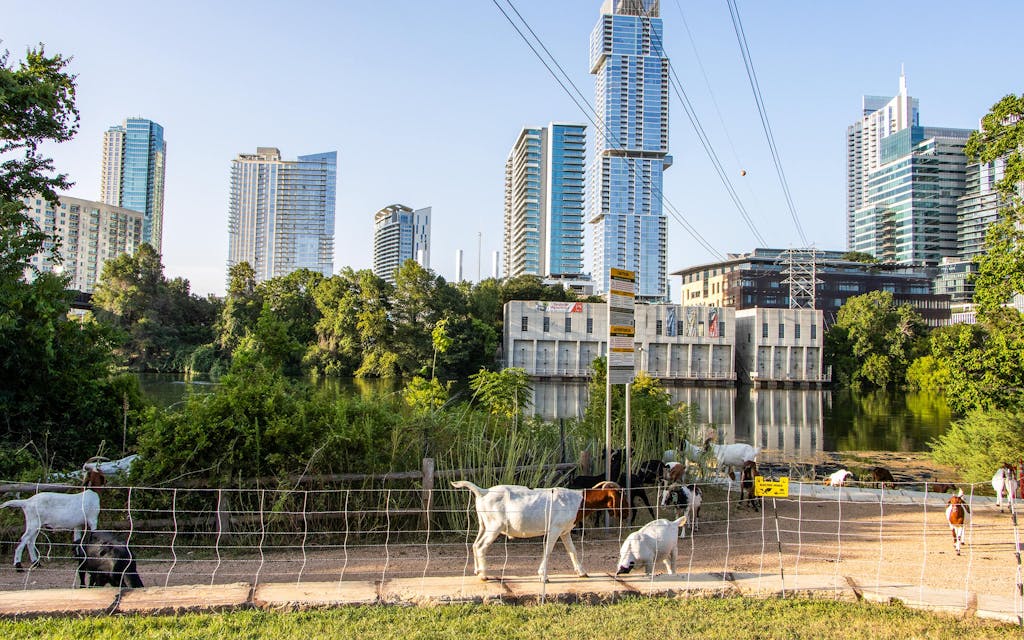Romeo approaches the electrified fence, lovestruck. What light through yonder fence breaks? It is the east, and Carolyn and Kyle Carr are the sun. The Carrs own Rent-a-Ruminant Texas, a grazing management company with four human employees and about six hundred goat staffers—with 2,400 stomach chambers between them. Goats’ four stomach chambers enable them to digest material that flummoxes people, digestively and logistically, making them valuable soldiers in the constant war against uninvited flora. Romeo, a taller goat with a white-and-beige face and tidy horns, is one of 85 rented ruminants that have been deployed to a northeastern bank of Austin’s Lady Bird Lake to help manage poison ivy.
But at the moment Romeo is distracted. “He is in love,” Carolyn says as he draws nearer to the fence, yearning for head scratches. Then she switches to a pleading tone. “No, no, get back. You can’t touch it, baby,” she says as the goat comes closer, with a smile—I swear to you, a smile!—on his face. “I would love to pet you, but—” It’s too late. The herd is trained to avoid the fences, but no wind, no rain, no fence can stop Romeo. It gives him a light zap, comparable to the shock static electricity gives humans, and he bounds away, spurned but, after a moment, unbothered. This is the rare occupational hazard of the dream job: professional eater.
Romeo’s colleagues are less besotted with their shepherds, and they munch happily at the poison ivy and weeds on the ground below. They are working next to a small inlet, crossable by wooden footbridge, and occasionally delighted kayakers greet them as they drift by. The goats do not enjoy water, and they don’t drink from the lake, Kyle says. “These are fancy goats. They only drink the filtered stuff.”
The herd is startlingly efficient and even organized—at certain times throughout the day, the entire group gathers together and lies down for a break. On the day of my visit, in early November, the goats have been working along the lake for a week already, with a little over a week to go before they return to the Carrs’ ranch in Brownwood, just south of Abilene. The opposite side of the inlet has already been neatly denuded. This is the herd’s second tenure on the Ann and Roy Butler Hike-and-Bike Trail: they were stationed along the trail for several weeks this past summer, and were so effective that the Trail Conservancy invited them back.
The cost of their services, says Heidi Anderson, executive director of the Trail Conservancy, will end up being about 5 cents per square foot (cost varies depending on terrain and vegetation), which is affordable compared to other methods of removing invasive species. “And the alternatives really are not great. Like controlled burns and pesticides—those kinds of things also create a lot of risk for the environment,” Anderson says. “There are certain types of chemicals we could use, but we’re right there on the watershed—right at the shoreline. So we really want to avoid that as much as we can.” Controlled burns and pesticides also lack a certain mystique. “They sneeze as an alarm,” Anderson says, awestruck. “I want to go out there and watch, I want to see if they sneeze!” (The Carrs confirm the goats do issue a sneeze-like snort to warn each other of danger. “One of them doing it, you’re like, Eh, whatever,” Kyle says. “But a hundred of them doing it . . . ”)


The Carrs started their business in 2016, when Kyle inherited some property from his family. It was completely overgrown with greenbriers and other unwanted species, Carolyn explains, but they didn’t want to bulldoze, for instance, because of the oak trees that dotted the land. Carolyn jokingly suggested bringing in grazers to take care of the problem, and Kyle thought it was an excellent idea. Goats were already widely in use on the West Coast, especially for wildfire prevention, but when the Carrs started googling, they couldn’t find any companies in Texas that offered goats for invasive-species management. (Rent-a-Ruminant is a national company which also has franchises in Florida, Illinois, and Washington; Rent-a-Ruminant North East Texas was started by another couple, Eric and Kim Cullum.) At the time, Carolyn worked for an events company—what is event planning if not herd management?—and Kyle worked in business analytics, but they decided to give goats a go(at).
In recent years, more and more locales have put goats to work. The Carrs do bring their goats to private properties across Texas occasionally, but not nearly as many as they expected they would; they generally field requests for larger tracts of land, such as the greenery surrounding University Parks Drive in Waco and Brackenridge Park in San Antonio. Rent-a-Ruminant is the company most commonly used by municipalities in Texas, but competitors are springing up. The goats are content to navigate terrain that stymies people. “We all have areas that are difficult to access and difficult to maintain—usually areas that are steep and deep—and they just require a significant amount of staff working by hand under extremely hot temperatures, especially in Texas,” says Eduardo Valerio, assistant director of stormwater operations with Dallas Water Utilities. In August, the department worked with a company called Open Space TX to bring goats in to help clear heavy underbrush that hindered stormwater flow and created a flood risk.
The Carrs’ herd, which began with about thirty members, has scaled up quickly to match demand. They began with Boer goats and Spanish goats, but other breeds have joined their ranks: occasionally a Lamancha, recognizable for its tiny, unsettlingly human ears, ambles by. A variety of heights is most effective, Kyle explains, because while the larger goats are able to pull six- and seven-foot-tall plants down, the smaller goats are skilled at wiggling into spaces their girthier counterparts don’t want to go. Carolyn and Kyle’s no-kill policy and frequent adoptions—including 65 goats from a rescue group in Florida—catalyzed the herd’s current headcount of six hundred. Their large numbers allow for concentrated grazing (which “stuns” the vegetation) and for shorter stints. “The faster we can move the goats in and through an area, the better for safety. And also, you don’t want to have goats there for months on end, you know?” I don’t know.
Their big break was a project at the Houston Arboretum & Nature Center in 2020. After the 2011 drought devastated Houston’s parks, the nonprofit had begun researching the methods by which the landscape had historically been sustained and managed, says Stephen Benigno, the arboretum’s conservation director. “One of them was prescribed fire, and the other was grazing,” he says. “Figuring out how to bring back grazing into this landscape, and seeing the possibility of bringing in a herd of goats to do that—that was incredible in terms of timing.” The goats would mimic the grazing of the bison that used to roam Texas.
The Carrs were terrified. Over the years they have developed a fairly deep knowledge of the state’s native and invasive species, but the arboretum felt like the big leagues. “I was really worried, because it’s such a beautiful place,” Kyle recalls. He and Carolyn have extensive conversations with clients prior to bringing the herd in to determine which plants they’d like targeted, which plants they’d like to preserve—Benigno says that they erect fencing around saplings and other trees in the arboretum that they want to protect from the goats—and what the goats’ limitations are. (The Carrs tell me they would never plant nandina, a type of bamboo, which is very pretty and popular, but which is toxic to many animals and very difficult to remove once it’s established—even the goats can’t penetrate the mature stalks.) “These goats are gonna ruin everything,” Kyle remembers thinking, “these people are gonna hate us.” But while the goats did consume native species during their sweep of the grounds, they went after invasive species such as blackberries and honeysuckle much more efficiently, Kyle says, and the native species grew back with renewed enthusiasm.

And the goats brought tremendous traffic to the arboretum. Starved for spectacle during lockdown, scores of Houstonians arrived every day to watch them work—the opposite of watching grass grow. It is peaceful to come across a herd noshing away: the goats are very quiet, and are unbothered by the footfalls of passing joggers, unbothered by current events. As a pastime it offers the same thrill of Norwegian slow television, which is: none. Standing among the Rent-a-Ruminant goats in Austin, I imagine a new LinkedIn profile for myself, with “shepherdess” as my title.
Heidi Anderson also appreciates the goat-peepers drawn to the hike-and-bike trail in Austin. In June 2022, the Trail Conservancy signed a formal agreement with Austin Parks & Recreation to take over the day-to-day operations for the entire Town Lake Metropolitan Park, which comprises about three hundred acres of parkland, including the trail. Community support is critical for the nonprofit’s new goals. “We’re not bringing the goats out there to get attention. We’re bringing them out there because they have a real, efficient, and effective role to play for us,” Anderson says. “But the silver lining is that through this project, and this program in particular, we’re catching the attention of people and giving ourselves the opportunity to educate them about who we are.” Ahead of the Rent-a-Ruminant herd’s second visit, members of the public were invited to “sponsor” goats. Many did, and have stopped by asking for help identifying their sponsees.
Most onlookers maintain a respectful distance, out of the same respect for the animals’ work that keeps me from petting K9 officers, and out of deference to the cluster of signs warning that the fence is electrified. To pet them would be disastrous anyway, because the poison ivy the goats are cavorting in can transfer to humans. “We don’t wash the goats, they would hate that,” Kyle says, but after about six to eight weeks the oils clear from their fur and skin. The threat of poison ivy keeps most people from doing anything rash (sorry).
But those who cannot pet, Instagram. As I stand with the Carrs watching the herd, two women in leggings and sweatshirts pause their stroll and leave the trail. Most of the goats have gathered on the far side of their enclosure, but the women have spotted them and must get closer. They pick their way through the unruly grass along the fence, as googly-eyed over the goats as Romeo was over his keepers. The two take pictures and coo for ten minutes, then begin to trace a path back the way they came, at which point one of the women yelps: the grasses are a minefield of green burrs, which have the shape of—and inflict the pain of—the spiked balls on medieval weapons. The other woman notices that burrs have nestled themselves into her shoelaces and leggings as well, and they spend several minutes picking them out before carrying on.
This may be the only downside to grazing management: that not without consequences—poison ivy, burrs, the electric nope! of the fence—may the alliance of goat and pedestrian be consummated with pets and nose boops. But we salute them from afar.








